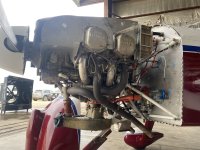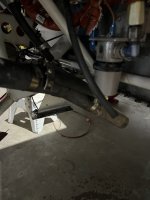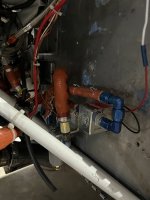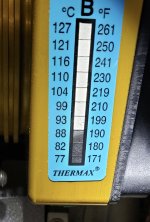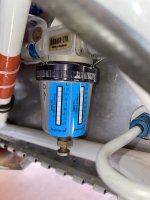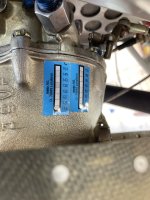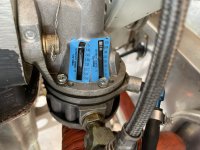So I think I had vapor lock yesterday but wanted to hear others thoughts on the topic as well, since I wasn't anticipating it given the conditions (mainly the temp which I thought would generally need to be warmer to cause it).
I'm flying an O-360A1A (carb) with 92 octane non-ethanol. I flew to another airport about 10 or 12 minutes and landed and shut down for 5 minutes. Fired up just fine and taxi over to take off. Taxi was about 2 minutes I'd estimate. As I am just approaching the hold short I thought I might have had a single stumble but not very clear. I ask for takeoff clearance aftera few seconds and apply small power to get onto the runway and that is when it started to barely run.
Tried to give it a little more fuel and lean it but nothing helped and it died before rolling to centerline. I had already asked for canceling clearance but took some time to finally start up and run, with a lot of missing to get back to an FBO to have them add 2.8 gallons of 100LL to my 16 gallon tank of mogas.
Throughout the time it was running rough I had 8psi registered on my mechanical fuel pressure gauge and my electric pump running. My CHT are never very hot in flight (barely over 300 on climbs) and were only 270 during the event. I tried many of things to get it to improve such as leaning to almost idle cutoff and turning off the electric pump temporarily. Each of those two things seemed to help it run marginally better as I taxied to the FBO. One other unique thing was when I used idle cutoff to shut it down, it dieseled / kept running for over a minute, probably 2. Tried giving it more throttle, turning off electric boost pump and even turning the fuel selector to off (but it wouldn't have run dry during the duration of the event). I think it finally shut off after a couple quick blast of throttle then back all the way off.
Let it sit for over 30 minutes with the oil door open and dipstick unscrewed. Then it fired up fine (still mogas since it takes time to get the new mix through lines? But started to slightly miss but as I taxied down to what was going to be a nice long run up with higher settings for a minute or two based on recommendations I've read on the past to clear the vapor it seemed to be running better and I was taxiing at 1500rpm (brakes don't like that as much though). Then, all the sudden full electrical failure. I believe the reason for it is my shorai doesn't have all the protections and it wasn't happy with all the draw down and rapid charge from alternator. I mention it because I didn't end up doing my long run up to verify all clear and confirming (as best I could) it was vapor lock. Now I left the plane and got a ride home and ordered a battery which is a week out.
Summary event statistics
I'm flying an O-360A1A (carb) with 92 octane non-ethanol. I flew to another airport about 10 or 12 minutes and landed and shut down for 5 minutes. Fired up just fine and taxi over to take off. Taxi was about 2 minutes I'd estimate. As I am just approaching the hold short I thought I might have had a single stumble but not very clear. I ask for takeoff clearance aftera few seconds and apply small power to get onto the runway and that is when it started to barely run.
Tried to give it a little more fuel and lean it but nothing helped and it died before rolling to centerline. I had already asked for canceling clearance but took some time to finally start up and run, with a lot of missing to get back to an FBO to have them add 2.8 gallons of 100LL to my 16 gallon tank of mogas.
Throughout the time it was running rough I had 8psi registered on my mechanical fuel pressure gauge and my electric pump running. My CHT are never very hot in flight (barely over 300 on climbs) and were only 270 during the event. I tried many of things to get it to improve such as leaning to almost idle cutoff and turning off the electric pump temporarily. Each of those two things seemed to help it run marginally better as I taxied to the FBO. One other unique thing was when I used idle cutoff to shut it down, it dieseled / kept running for over a minute, probably 2. Tried giving it more throttle, turning off electric boost pump and even turning the fuel selector to off (but it wouldn't have run dry during the duration of the event). I think it finally shut off after a couple quick blast of throttle then back all the way off.
Let it sit for over 30 minutes with the oil door open and dipstick unscrewed. Then it fired up fine (still mogas since it takes time to get the new mix through lines? But started to slightly miss but as I taxied down to what was going to be a nice long run up with higher settings for a minute or two based on recommendations I've read on the past to clear the vapor it seemed to be running better and I was taxiing at 1500rpm (brakes don't like that as much though). Then, all the sudden full electrical failure. I believe the reason for it is my shorai doesn't have all the protections and it wasn't happy with all the draw down and rapid charge from alternator. I mention it because I didn't end up doing my long run up to verify all clear and confirming (as best I could) it was vapor lock. Now I left the plane and got a ride home and ordered a battery which is a week out.
Summary event statistics
- Carb
- Temp was 70 degrees at the metar 30 minutes before the event and cooling (next metar was 66)
- 5 minute turn on the ground
- CHTs only 270 during the event
- Fuel pressure maintained normal for my plane (just shy of 8psi with electric pump on)
- 92 non-ethanol which was purchased less then 4 weeks ago (probably about 2 or 3) so tail end of March
- Have gascolator
- No water or contaminates found when I sumped before flight or before taking the 2.8g of 100LL



